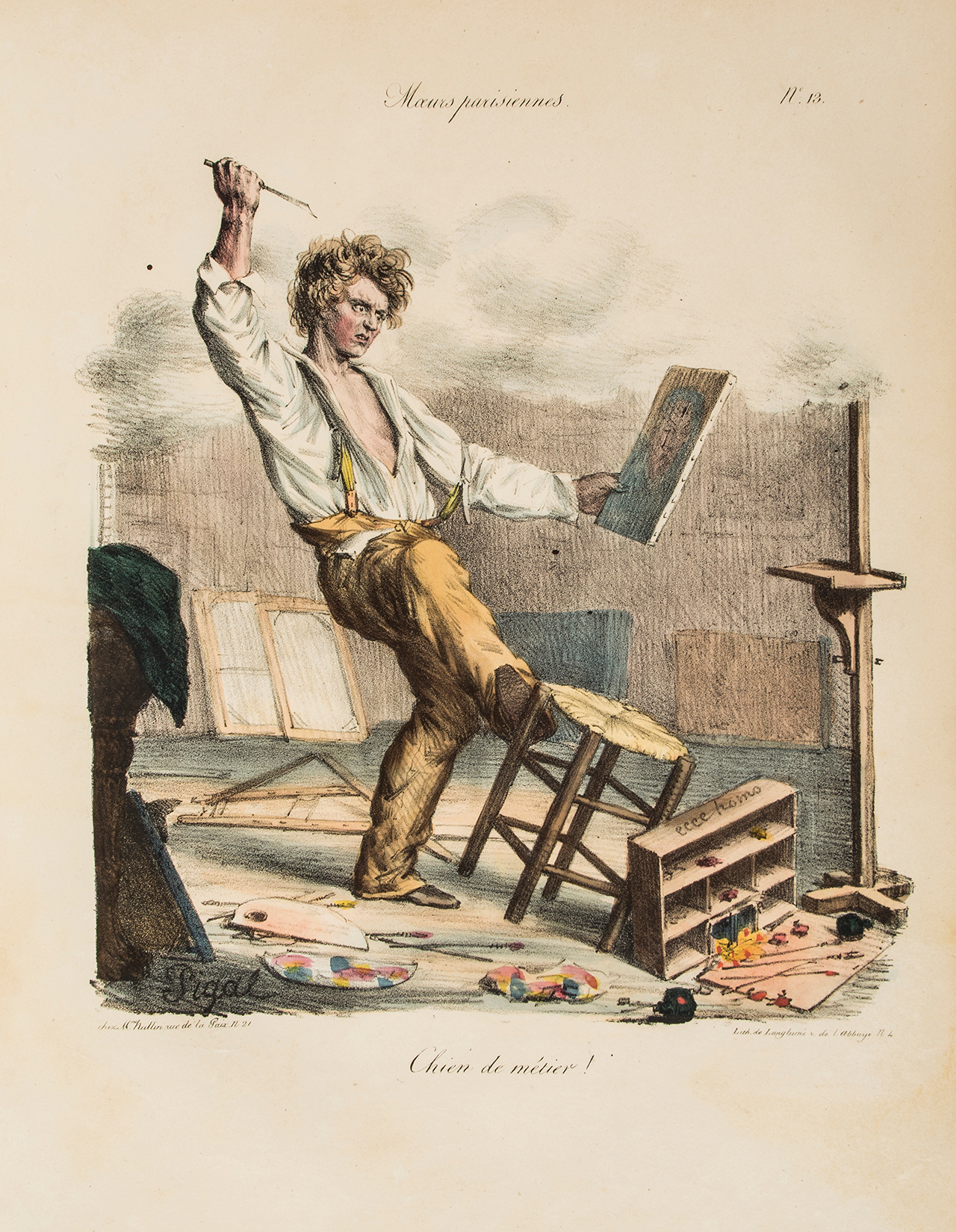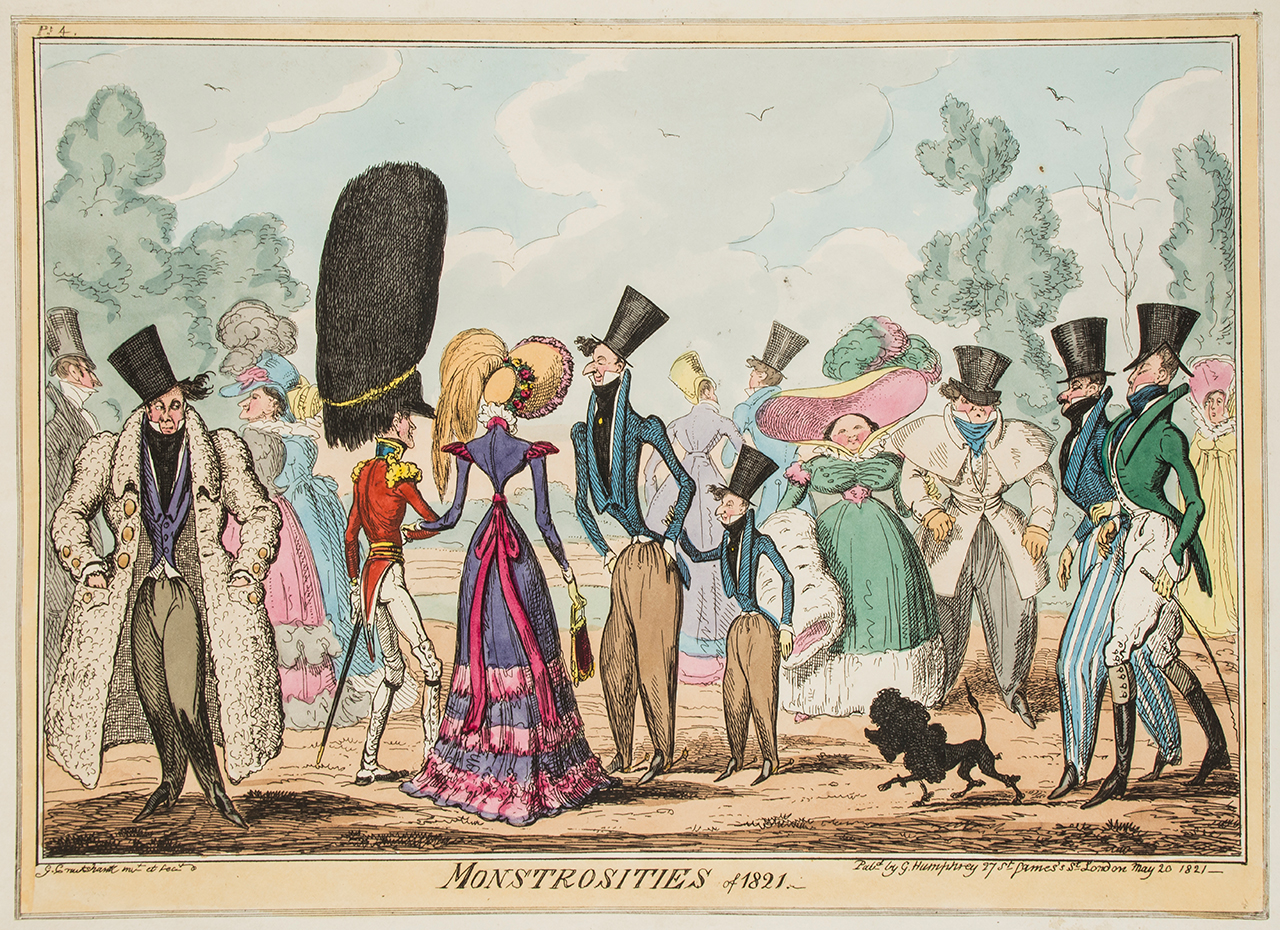
James Gillray, “The Plumb-pudding in danger, _ or _ State Epicures taking un Petit Souper” (1805), original hand-colored etching on wove paper, 260 x 360 mm. Pitt and Napoleon, both in full uniform, seated either side of the globe, a large plum pudding, Pitt using a knife to carve a large slice through the Atlantic, to include the West Indies, while Napoleon uses a large sword to carve Europe away, leaving only the British Isles, Scandinavia and Russia. (click to enlarge) (all images courtesy Bloomsbury Auctions)
The late 18th century was a golden age of satire in Britain. Etched cartoons and caricatures abounded, poking fun at kings, noblemen, society ladies, French revolutionaries, the institution of marriage, and countless other people and things. “The absence of absolutism in Britain carried with it a relative freedom of the press,” writes Stephen J. Bury in Oxford Art Online, by way of explaining the cartoon combustion of the time. “Technological developments encouraged a switch from verbal to visual satire, and the era witnessed the development of a social context for debate, whether in the coffee-house, club, or on the street.” Other factors cited by Bury include relatively easy means of production and distribution, new publishers, and “the appearance of a number of great artists on the scene.”
Three of those great artists were James Gillray (1756/7–1815), Thomas Rowlandson (1756–1827), and George Cruikshank (1792–1878), all of whom are represented in an upcoming sale at Bloomsbury Auctions of Napoleonic and Georgian social and political satire. The sale features over 200 works, split between the collections of one Lord Baker of Dorking and an unnamed “gentleman.” Lord Baker’s collection features images of Napoleon, including the earliest known representations of the general in English caricature, by Isaac Cruikshank (George’s father) in 1797 and 1798. As the press release for the sale notes, Cruikshank “had clearly never actually seen his subject”; his Napoleon is a tall, skinny, curly-lipped man with a vengeful look in the eyes as he kicks the papal tiara off the Pope’s head.

Thomas Rowlandson, “The Dunghill Cock and Game Pullet or Boney Beat out of the Pitt” (1810), original hand-colored etching, 240 x 345 mm. Satirizes aspects of Napoleon’s new marriage to Marie Louise of Austria, following his divorce from Josephine for failing to produce an heir, full of sexual innuendo in military terms. (click to enlarge)
Later Napoleon cartoons include an amazingly astute one by James Gillray from 1805, which shows then Prime Minister William Pitt and Napoleon greedily carving up the globe with forks and knives (title: “The Plumb-pudding in danger, _ or _ State Epicures taking un Petit Souper”). Two by Rowlandson, in 1810, satirize Napoleon’s marriage to Marie Louise of Austria, who alternately screams her hatred for him and taunts him with promise of a “flag of truce” while calling him “Boney.” That cartoon pretty well drips with sexual innuendo (its title is “The Dunghill Cock and Game Pullet or Boney Beat out of the Pitt”) — gossip that arose because Napoleon had failed to produce an heir with his first wife, Josephine. Another cartoon from the same auction set, by an anonymous creator (also 1810), shows Napoleon and Marie Louise at the breakfast table, both red-faced and arguing over the fact that Boney has “done NOTHING” to her.
The sale’s second collection focuses on broader social satire from the Georgian period, including George Cruikshank’s hilarious Monstrosities of Fashion series (1816–26), which simultaneously captures and lampoons the styles of the day by grossly exaggerating shapes and proportions. A boxing broadside illustrated by Gillray in 1790 features one of the earliest examples of sports journalism, whose headline begins, “A SCIENTIFIC ACCOUNT of the concluding battle between those Champions of the Fist…” And one of my personal favorites is a c. 1823 hand-colored lithograph by Edme-Jean Pigal — from a collection studying “Parisian Manners” — which shows an anguished young artist kicking his stool, clutching a sharp tool in one hand (maybe a palette knife) and a painting in the other (if you look closely, you can see gashes), and yelling, “Chien de métier!” (literally “dog business”).
Nothing’s changed! Painting is still a dog business, suspenders are still in, and as yesterday proved, we still need political cartoons as much as ever.

Edme-Jean Pigal, ‘Moeurs Parisiennes,’ plate 13 (c. 1823), hand-colored lithograph by Langlumé after Pigal

George Cruikshank, ‘Monstrosities of Fashion’ (1816–26), 1 from set of 8 hand-colored etchings (click to enlarge)

George Cruikshank, ‘Monstrosities of Fashion’ (1816–26), 1 from set of 8 hand-colored etchings

James Gillray, “A French Gentleman of the Court of Louis XVIth, A French Gentleman of the Court of Egalité, 1799″ (1799), original hand-colored etching, 260 x 360 mm. An elegantly dressed courtier of the ancient regime bows low to his successor, saying “Je suis votre tres humble serviteur,” to which the course-featured revolutionary, in a heavy coat with a cudgel protruding from the pocket, replies “Baisez mon cul.” (click to enlarge)

Isaac Cruikshank, “Buonaparte at Rome, giving Audience in State” (1797), engraving, 270 x 370 mm. The first appearance of Napoleon in English caricature, a response to the rumors he had entered Rome and humiliated the Pope. (click to enlarge)

Anonymous satire on Napoleon’s marriage to Marie Louise of Austria, “Boney and his New Wife, or a Quarrell about _ Nothing!!” (1810) (click to enlarge)

James Gillray, “The Manner in which Mendoza Caught Humphries twice, & Generously laid him down without taking the advantage of his Situation” (1790), famous Jewish boxer Daniel Mendoza stops his opponent Richard Humphreys from falling, hand-colored etching attached to letterpress account “A Scientific Account of the concluding Battle…,” 260 x 375 mm, sheet 430 x 390 mm (click to enlarge)
Bloomsbury Auctions’ Caricatures: Napoleonic and Georgian Social & Political Satire salewill take place on June 25.


Δεν υπάρχουν σχόλια:
Δημοσίευση σχολίου